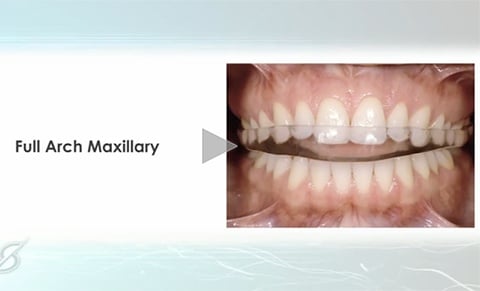Converting an Anterior Bite Plane to a Full Arch Splint
By Kevin Huff on January 28, 2018 |In the Occlusion in Clinical Practice Workshop at Spear Education, multiple types of bite splints, or orthotic appliances, are discussed in detail. The “go-to” diagnostic - and often therapeutic - appliance for many Spear-trained dentists is the anterior flat-plane appliance. It is used primarily for three purposes:
- To rule out joint pain from muscle pain
- To reduce hyperactivity of the muscles of mastication via the nociceptive trigeminal inhibition system
- To protect the dentition from parafunctional damage
Because the practice of dentistry is a dynamic process, the initial condition being treated or ruled out may bring another condition or challenge to light. Occlusal appliances often need to serve more than one purpose depending on the needs of the patient, which may vary from one appointment to the next. For example, there are occasions when an anterior bite plane appliance needs to be converted to a full arch appliance to best meet the needs of the patient.
As taught in the Occlusion in Clinical Practice Workshop, a flat plane appliance is first fabricated from a 1.5mm Biocryl shell pressed to an accurate model (preferably poured out of die stone from a polyvinyl impression for accuracy). Isofolan is used as a spacer in a separate pressing step between the stone and the Biocryl.
The anterior flat platform is fabricated either indirectly in the laboratory with methyl methacrylate acrylic, which adheres well to the Biocryl, or directly chairside with either methyl methacrylate or light-cured composite resin. The steps for applying composite resin are as follows:
- Air-abrade the Biocryl cameo surface with aluminum oxide
- Apply a composite bonding agent (Scotchbond Universal, Excite, etc.) and cure
- Apply a light-cured resin material (Triad, Durasplint, etc.)
- Mold the resin with a “whale tale” or flat spatula to approximate the optimal incisal plane
- Cure the anterior platform thoroughly with a chairside curing light or Triad light oven
- Finish and polish.


Anterior platform appliances are extremely helpful for patients who present with orofacial pain where the origin is nebulous between pain from an intracapsular disorder or from myalgia. If, after a day or two of wear, the pain is significantly reduced, even in the presence of joint noises, it is likely that the origin of pain is muscle.
However, if pain worsens within a day or two of wearing this appliance, then the pain origin is likely due to an intracapsular disorder, because the anterior bite plane actually increases load to the joint. In this case, or when it is not desirable to load the joints long term (arthrosis, for example) posterior centric stops can easily and quickly be added to this appliance in the following direct manner, using either polymethylmethacrylate acrylic or by following the steps to bond composite resin as outlined previously for the anterior platform (depending on clinician preference):
- Place a roll of resin along the central grooves of the posterior teeth on the cameo surface of the appliance after preparing according to the desired resin used (paint with monomer or air-abrade and bond)
- Mould the role over the occlusal contact areas
- Guide the patient's mandible gently into the resin until the anterior teeth touch the anterior platform on the centric contacts previously established
- Have the patient open and cure the resin or allow it to cure before removing the appliance from the mouth
- Remove the appliance and disinfect
- Mark centric stops with a sharp pencil
- Remove all excess acrylic from the posterior aspect of the appliance (except for the pencil marks) and taper contours away from the centric stops. With the occlusal surface of the appliance facing up, the posterior contacts should appear to be mountain peaks with hillsides tapering away.
- Finish and polish
- Return to mouth and confirm balanced and even centric stops with no posterior interferences. The anterior platform and contacts should have remained unchanged.





This technique eliminates many of the appointments and much of the chair time associated with other types of full-coverage appliances, because the eccentric contacts are ruled out initially with the anterior platform.
Materials used: Biocryl from Great Lakes and formed from the MiniStar; Yates Motloid Coldpac Tooth Acrylic Temporary Crown & Bridge Material. Alternatively, Triad or composite could have been used and bonded to the Biocryl.
(Click this link for more dentistry articles by Dr. Kevin Huff.)
Kevin D. Huff, D.D.S., Spear Moderator and Contributing Author - www.doctorhuff.net
FREE COURSE: Appliance Choices for Wear Patients
Now that you've read about anterior bite planes, learn about even more appliance choices. In this free course from the Spear Online Course Library, you will learn how to design and build appropriate appliances for your wear patients.
WATCH NOW